
Dimdima
Online Children's Magazine from India

Dimdima
Online Children's Magazine from India
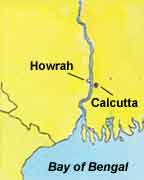
Kolkata. the capital of West Bengal is the second largest city of India. It used to be the capital of British India until the beginning of this century.
Kolkata's General Post Office stands at the site where the British had built their first fort. The fort was destroyed by Siraj ud Daula (the Nawab of Bengal) during the famous Black Hole incident of 1756, when around 123 Britishers imprisoned in a small guard-room measuring about 6mx4m are said to have died of suffocation. A black marble tablet at the northeast corner of the post office marks the site of this incident.
The British built another fort more massive and impregnable than the first one in the village of Gobindapur and named it Fort William after King William III. This fort was never attacked and has the distinction of being the only large fort in India from whose battlements no shot was ever fired in anger.
The jungle around the fort was cleared to give an open field of fire. The vast open area that resulted- about 4km long and half as broad - known as the Maidan, is one of the largest urban parks in the world today.
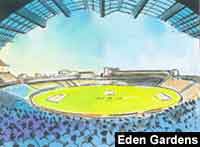 The famous Eden Gardens, where cricket matches are held, is in the Maidan. It was in these grounds that the Kolkata Cricket Club, the country's first cricket club was formed in 1792.
The famous Eden Gardens, where cricket matches are held, is in the Maidan. It was in these grounds that the Kolkata Cricket Club, the country's first cricket club was formed in 1792.
The Royal Kolkata Golf Club, the Mohan Bagan football club, which has the longest sequence of wins in domestic competitions and the Royal Kolkata Turf Club, which has the largest and longest race course in the country are also located in the Maidan.
Sights Of Kolkata
 Chowringhee Street, now called Jawahrlal Nehru Road, has the distinction of being the first Indian city to have been lit by gas lights, in 1859. Forty years later Kolkata became the first city in the country to go electric.
Chowringhee Street, now called Jawahrlal Nehru Road, has the distinction of being the first Indian city to have been lit by gas lights, in 1859. Forty years later Kolkata became the first city in the country to go electric.
The Victoria Memorial, which took 15 years to build was completed in 1921. Sometimes called the Taj Mahal of the Raj it was built in commemoration of Queen Victoria who died in 1901.
White makrana marble from Rajasthan was used in its construction.
 India's first underground metro railway runs between Tollygunge and Dum Dum, a distance of over 16 kilometres.
India's first underground metro railway runs between Tollygunge and Dum Dum, a distance of over 16 kilometres.
Kali is the patron goddess of Kolkata.
Close to the Kali temple at Kalighat is 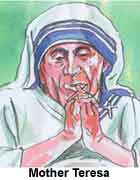 Nirmal Hriday,the home for the dying started by Mother Teresa. Clad in
Nirmal Hriday,the home for the dying started by Mother Teresa. Clad in
white cotton saris with blue borders, the nuns from her Missionaries of Charity work in the many homes, clinics and orphanages they run in the city.
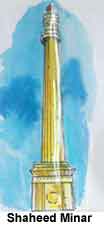 The 46 m tall Shaheed Minar was formerly known as Ochterlony monument. It was erected in 1828 as a memorial to Sir David Ochterlony who led East India Company troops against the Nepalese. There are 223 steps to the top.
The 46 m tall Shaheed Minar was formerly known as Ochterlony monument. It was erected in 1828 as a memorial to Sir David Ochterlony who led East India Company troops against the Nepalese. There are 223 steps to the top.
Nakhoda mosque built in 1926 to resemble Akbar's tomb at Sikandra, is the city's largest mosque. It can accommodate ten thousand people at a time.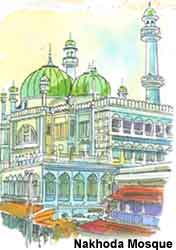
Writers' Building where originally the clerks of the East India Company worked, was completely refaced in 1880 and is now the state government secretariat.
Rabindranath Tagore was born at Jorasanko House in north Kolkata. He also breathed his last there. Tagore who 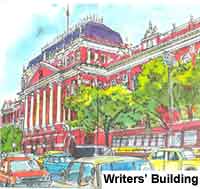 was reverently addressed as Gurudev was awarded the Nobel prize for literature for his collection of poems Gitanjali in 1913.
was reverently addressed as Gurudev was awarded the Nobel prize for literature for his collection of poems Gitanjali in 1913.
It is fitting that the literature prize should have gone to a man from Kolkata because the people of this city pride themselves on their literary traditions.
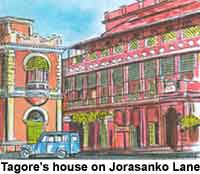 The National Library at Alipore is the largest in the country with 51 kilometres of steel shelves that hold nearly 2 million books and manuscripts. It also houses the Ashutosh Mookerjee collection, the world's largest private collection of books.
The National Library at Alipore is the largest in the country with 51 kilometres of steel shelves that hold nearly 2 million books and manuscripts. It also houses the Ashutosh Mookerjee collection, the world's largest private collection of books.
Another of Kolkata's famous buildings is the Marble Palace. The palatial mansion and its ornamental garden was built in 1835 by a wealthy Bengali merchant, Raja Rajendra Mullick who had a passion for collecting works of art.  The rooms and apartments are crammed with statues and paintings and other objets d'art that the Raja obtained from various parts of the world.
The rooms and apartments are crammed with statues and paintings and other objets d'art that the Raja obtained from various parts of the world.
It is the private home of the Raja's descendants who continue the family tradition of feeding the poor everyday at noon.
Last updated on :9/24/2005
Dimdima is the Sanskrit word for ‘drumbeat’. In olden days, victory in battle was heralded by the beat of drums or any important news to be conveyed to the people used to be accompanied with drumbeats.
Bharatiya Vidya Bhavan
K. M Munshi Marg,
Chowpatty, Mumbai - 400 007
email : editor@dimdima.com
Bharatiya Vidya Bhavan
505, Sane Guruji Marg,
Tardeo, Mumbai - 400 034
email : promo@dimdima.com
Dimdima.com, the Children's Website of Bharatiya Vidya Bhavan launched in 2000 and came out with a Printed version of Dimdima Magazine in 2004. At present the Printed Version have more than 35,000 subscribers from India and Abroad.